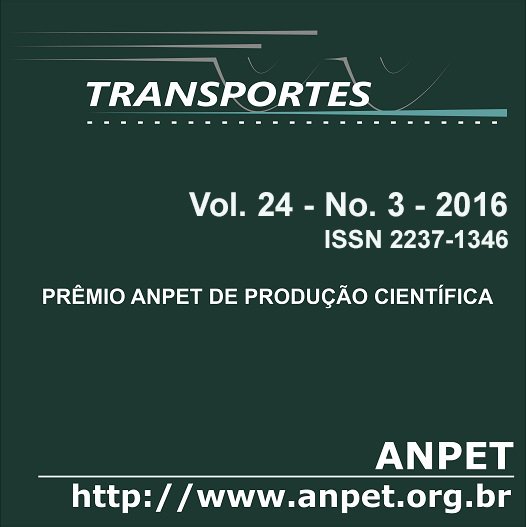Acessibilidade estrutural na cidade de São Carlos, SP, Brasil
DOI:
https://doi.org/10.14295/transportes.v24i3.1082Keywords:
Structural Accessibility, Transportation and Land Use.Abstract
The Structural Accessibility Layer (SAL) is the geographical representation of comparative accessibility levels by types of transport to different types of opportunities generating travel. The tool is based on integrated considerations regarding transport and land use systems. It was validated using the case study of its application on Greater Oporto. This paper aims at analyzing the accessibility levels of São Carlos using the proposed method. To accomplish this, Census data and results from an Origin and Destination survey were used. Thus, this study shows the Structural Accessibility Layer as a feature that supports the urban transportation planning, as can be observed in the application conducted in the city of São Carlos. In addition, the study supports the transferability of the application of SAL to the Brazilian case.Downloads
References
Bertolini, L.; F. Clercq e L. Kapoen (2005) Sustainable Accessibility: a Conceptual Framework to Integrate Transport and Land Use Plan-Making. Two Test-Applications in the Netherlands and a Reflection on the Way Forward. Transport Policy, v. 12, n. 3, p. 207-220. DOI: 10.1016/j.tranpol.2005.01.006.
Cervero, R. (2003) Growing Smart by Linking Transportation and Land Use: Perspectives from California. Built Environment, v. 29, n. 1, p. 66-78. DOI: 10.2148/benv.29.1.66.53948.
Ewing, R. e R. Cervero (2001) Travel and the Built Environment: a Synthesis. Transportation Research Record, v. 1780, pp. 89-91. DOI: 10.3141/1780-10.
Halden. D. (2002) Using Accessibility Measures to Integrate Land Use and Transport Policy in Edinburgh and the Lothians. Transport Policy, v. 9, n. 4, p. 313-324. DOI: 10.1016/S0967-070X(02)00017-3.
IBGE (2015) Instituto Brasileiro de Geografia e Estatística. Acessado em 2015-01-30, de http://www.ibge.gov.br.
Papa, E.; Silva, C.; Brömmelstroet, M. e A. Hull (2015) Accessibility instruments for planning practice: A review of European experiences. The Journal of Transport and Land Use, v. 9, n. 3, p. 1-20. DOI: 10.5198/jtlu.2015.585.
Raia Junior, A. A. (2000) Acessibilidade e Mobilidade na Estimativa de um Índice de Potencial de Viagens Utilizando Redes Neurais Artificiais e Sistemas de Informações Geográficas. Tese de Doutorado, Escola de Engenharia de São Carlos, Universidade de São Paulo, São Carlos. DOI: 10.11606/T.18.2000.tde-10112001-160812.
Reis, J. P. F. F. (2009) Urban Structure and Mobility - A case study in Copenhagen. Dissertação de Mestrado, Centro de Pesquisa Transporte e Ambiente, Universidade do Porto. Acessado em 2016-08-24, de http://hdl.handle.net/10216/58033.
Rodrigues da Silva, A. N. (1998) Sistemas de Informações Geográficas para Planejamento de Transportes. Tese de Livre Docência, Escola de Engenharia de São Carlos, Universidade de São Paulo, São Carlos. Acessado em 2015-07-15, de http://www.teses.usp.br/teses/disponiveis/livredocencia/18/tde-03022006-154920/.
Rodrigues da Silva, A. N. (2008) Pesquisa Origem-Destino da cidade de São Carlos. Relatório do projeto de pesquisa FAPESP (Fundação de Amparo à Pesquisa do Estado de São Paulo) número 04/15843-4. São Carlos.
Silva, C. (2008) Comparative Accessibility for Mobility Management: The Structural Accessibility Layer. Tese de Doutorado, Centro de Pesquisa Transporte e Ambiente, Universidade do Porto. Acessado em 2016-08-24, de http://citta.fe.up.pt/publications/phd-theses/comparative-accessibility-for-mobility-management-the-structural-accessibility-layer.
Silva, C. e P. Pinho (2010) The Structural Accessibility Layer (SAL): Revealing How Urban Structure Constrains Travel Choice. Environment and Planning A, v. 42, n. 11, p. 2735-2752. DOI: 10.1068/a42477.
Silva, C. (2013) Structural Accessibility for Mobility Management. Progress in Planning, v. 81, p. 1-49. DOI: 10.1016/j.progress.2012.07.001.
Tan, F. (2013) Estudo das características de infraestrutura, tecnologia e operação de veículos leves sobre trilhos (VLT) visando à implantação em cidades de médio porte. Relatório de Iniciação Científica, Escola de Engenharia de São Carlos.
UN-Habitat (2013) Planning and Design for Sustainable Urban Mobility: Policy Directions. United Nations Human Settlements Programme, Nairobi; Earthscan from Routledge, Abingdon [etc.]. Acessado em 2016-08-24, de http://unhabitat.org/books/planning-and-design-for-sustainable-urban-mobility-global-report-on-human-settlements-2013/.
Wee, B. (2002) Land Use and Transport: Research and Policy Challenges. Journal of Transport Geography v. 10, n. 4, p. 259-271. DOI: 10.1016/S0966-6923(02)00041-8.
Wegener, J. e F. Fürst (1999) Land-Use Transport Interaction: State of the Art. TRANSLAND European Commission. DOI: 10.2139/ssrn.1434678.
Downloads
Published
How to Cite
Issue
Section
License
Authors who submit papers for publication by TRANSPORTES agree to the following terms:
- The authors retain the copyright and grant Transportes the right of first publication of the manuscript, without any financial charge, and waive any other remuneration for its publication by ANPET.
- Upon publication by Transportes, the manuscript is automatically licensed under the Creative Commons License CC BY 4.0 license. This license permits the work to be shared with proper attribution to the authors and its original publication in this journal.
- Authors are authorized to enter into additional separate contracts for the non-exclusive distribution of the version of the manuscript published in this journal (e.g., publishing in an institutional repository or as a book chapter), with recognition of the initial publication in this journal, provided that such a contract does not imply an endorsement of the content of the manuscript or the new medium by ANPET.
- Authors are permitted and encouraged to publish and distribute their work online (e.g., in institutional repositories or on their personal websites) after the editorial process is complete. As Transportes provides open access to all published issues, authors are encouraged to use links to the DOI of their article in these cases.
- Authors confirm they have obtained all required employer permissions for the publication and CC BY 4.0 licensing of the manuscript, particularly if the employer holds any claim to the manuscript's copyright. Authors assume all responsibility for employer-related copyright issues, releasing ANPET and Transportes from any related liability.
- Authors assume full responsibility for the content of the manuscript, including the necessary and appropriate authorizations for the disclosure of collected data and obtained results, releasing ANPET and Transportes from any responsibility in this regard.
Last update: 11/27/2025











